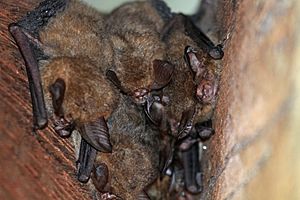Eastern long-eared bat facts for kids
Quick facts for kids Eastern long-eared bat |
|
|---|---|
 |
|
| Conservation status | |
| Scientific classification |
The eastern long-eared bat is a small flying mammal. It's a type of bat called a vespertilionid bat. You can find it in eastern Australia and Papua New Guinea. Its scientific name is Nyctophilus bifax.
Contents
Naming the Eastern Long-eared Bat
Scientists give every animal a special name. This helps them study and understand different species. The eastern long-eared bat was first described in 1915. A scientist named Oldfield Thomas gave it its scientific name. He studied a male bat found near Herberton in Queensland, Australia.
People sometimes call this bat other names. These include the northern long-eared bat or the north Queensland long-eared bat.
What the Eastern Long-eared Bat Is Like
This bat is a member of the Nyctophilus group. These are smaller bats that mostly eat insects. They belong to a large bat family called Vespertilionidae, also known as common evening bats.
How It Flies and Hunts
The eastern long-eared bat can fly in quick, straight lines. This is a bit unusual for Nyctophilus bats. However, it can also fly slowly and hover. This helps it catch its food.
These bats hunt in a few ways. They can "glean," which means picking insects off leaves or tree bark. They might also perch somewhere and wait. Sometimes, they even catch insects from the ground.
Where the Eastern Long-eared Bat Lives
The eastern long-eared bat likes to live in certain places. You might find it under loose, papery bark on melaleuca trees. It also lives among thick leaves or inside tree hollows.
Its Home Environment
This bat mostly lives in wet forests. These areas are found between Cape York and northern New South Wales in Australia. They prefer rainforests and areas near permanent water.
They also use drier areas close to these wet habitats. These include woodlands and forests. These places offer good spots for food or safe places to rest. You can often see them hunting at the edge of forests. A well-known group lives in the Chillagoe-Mungana Caves National Park.
Its Range and Status
In Australia, these bats live in warmer, subtropical areas. They have also been seen in a few different places in New Guinea.
The IUCN Red List helps us know how animals are doing. In 2008, the eastern long-eared bat was listed as "Least Concern." This means it is widespread and its numbers are not dropping.
See also
 In Spanish: Nyctophilus bifax para niños
In Spanish: Nyctophilus bifax para niños



